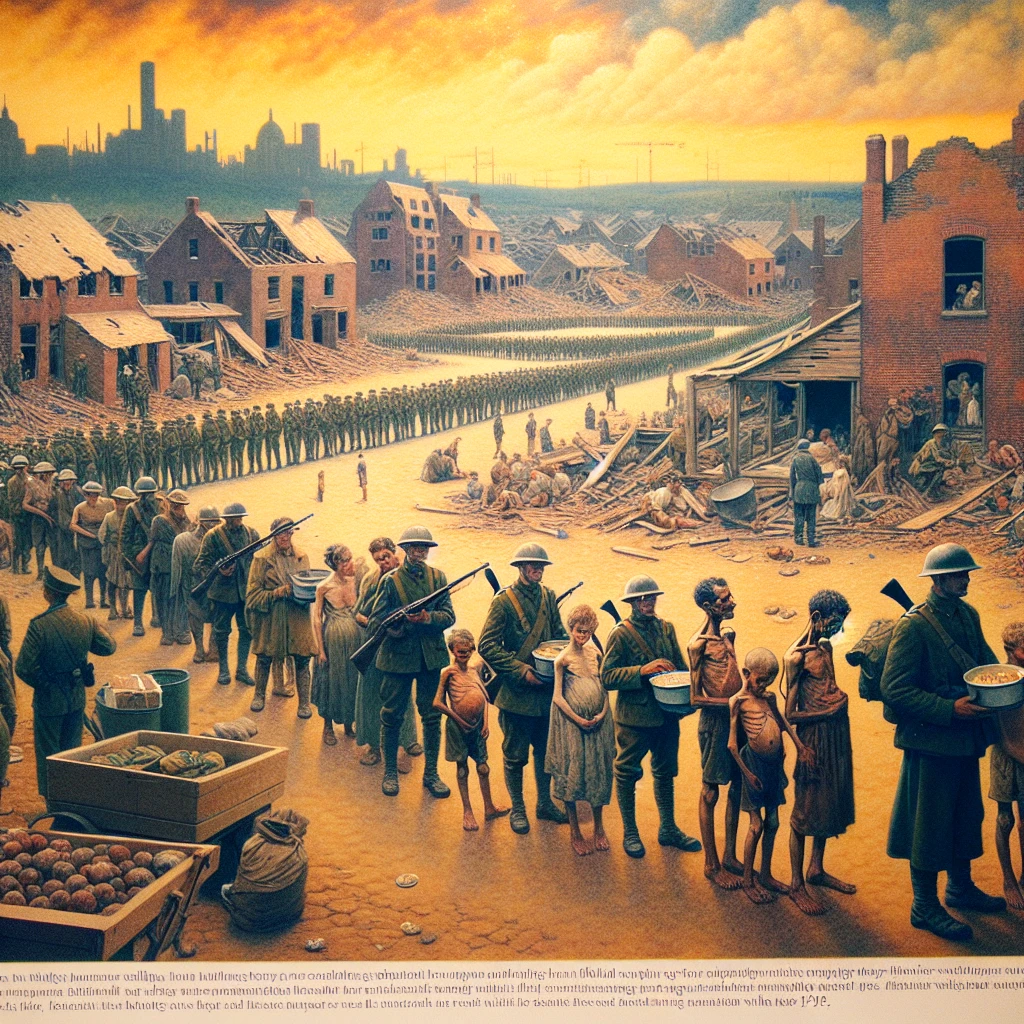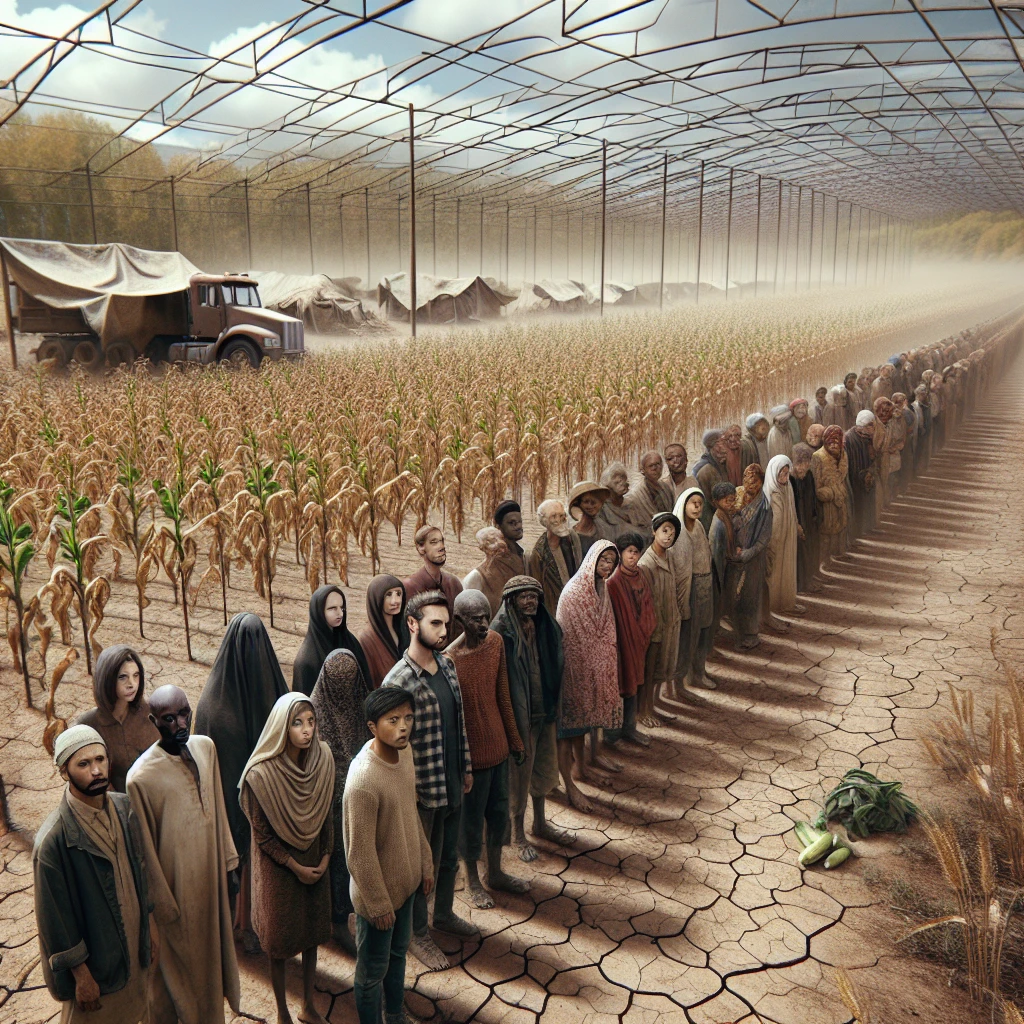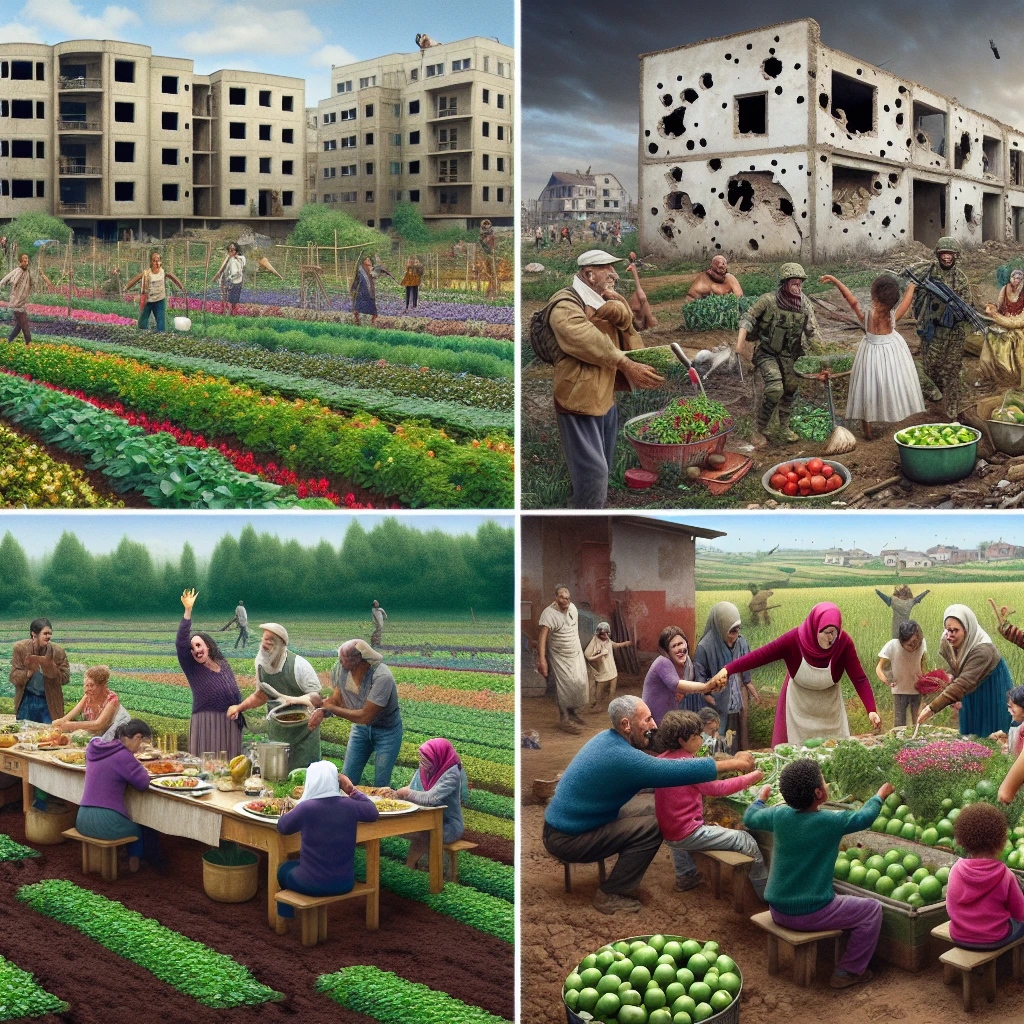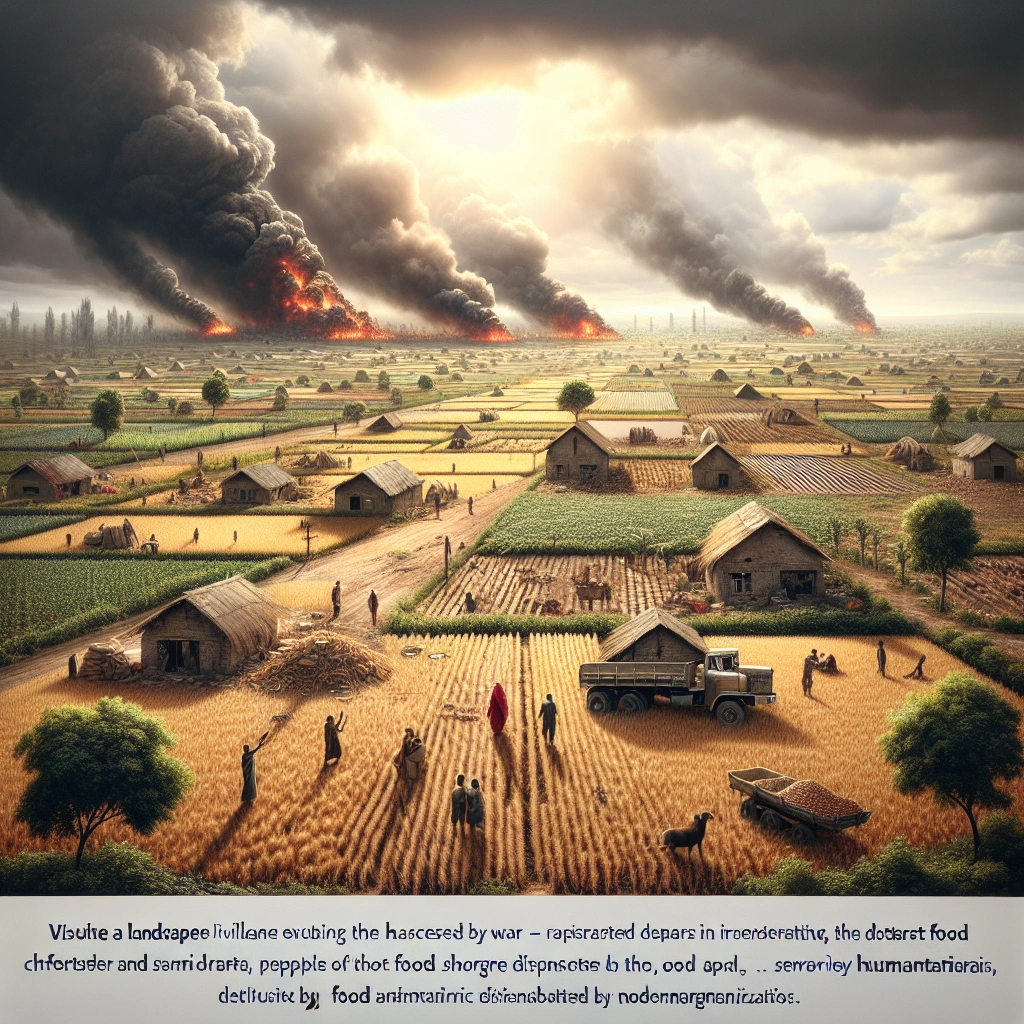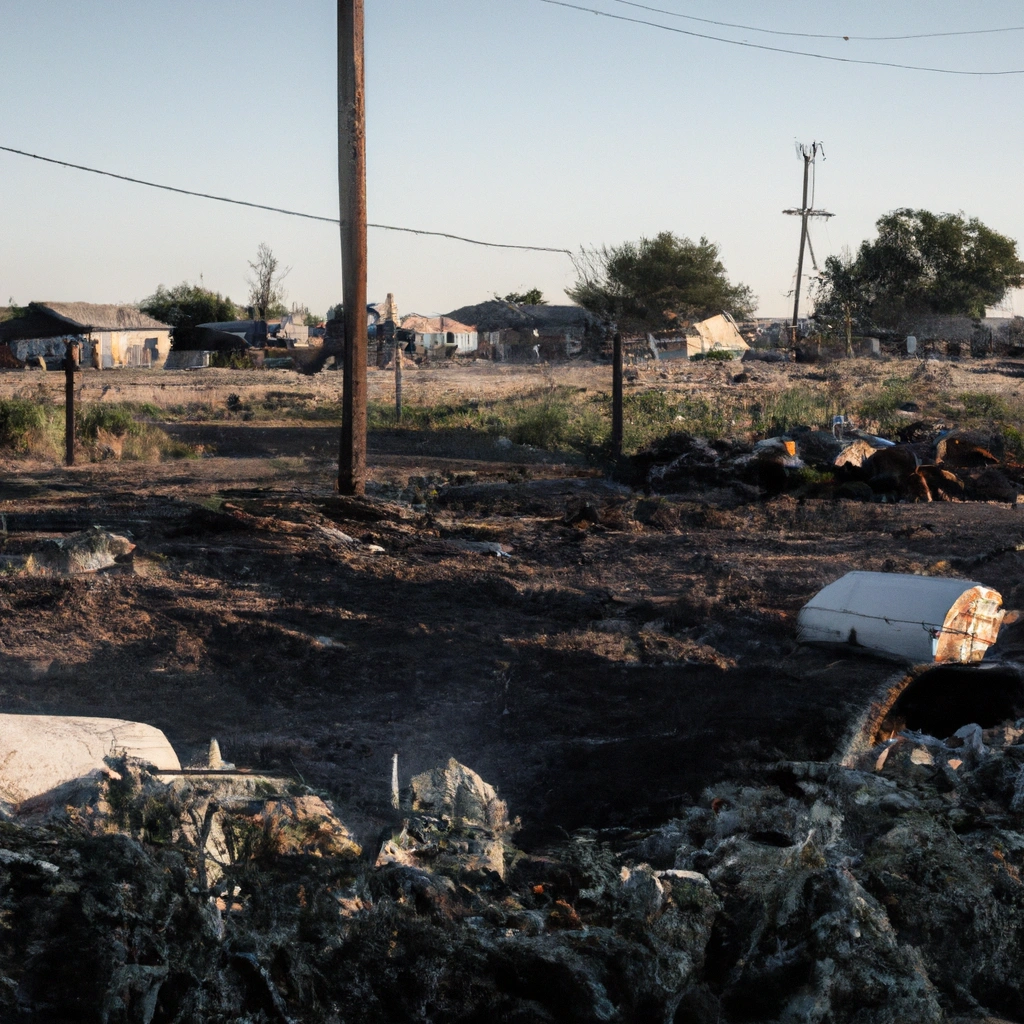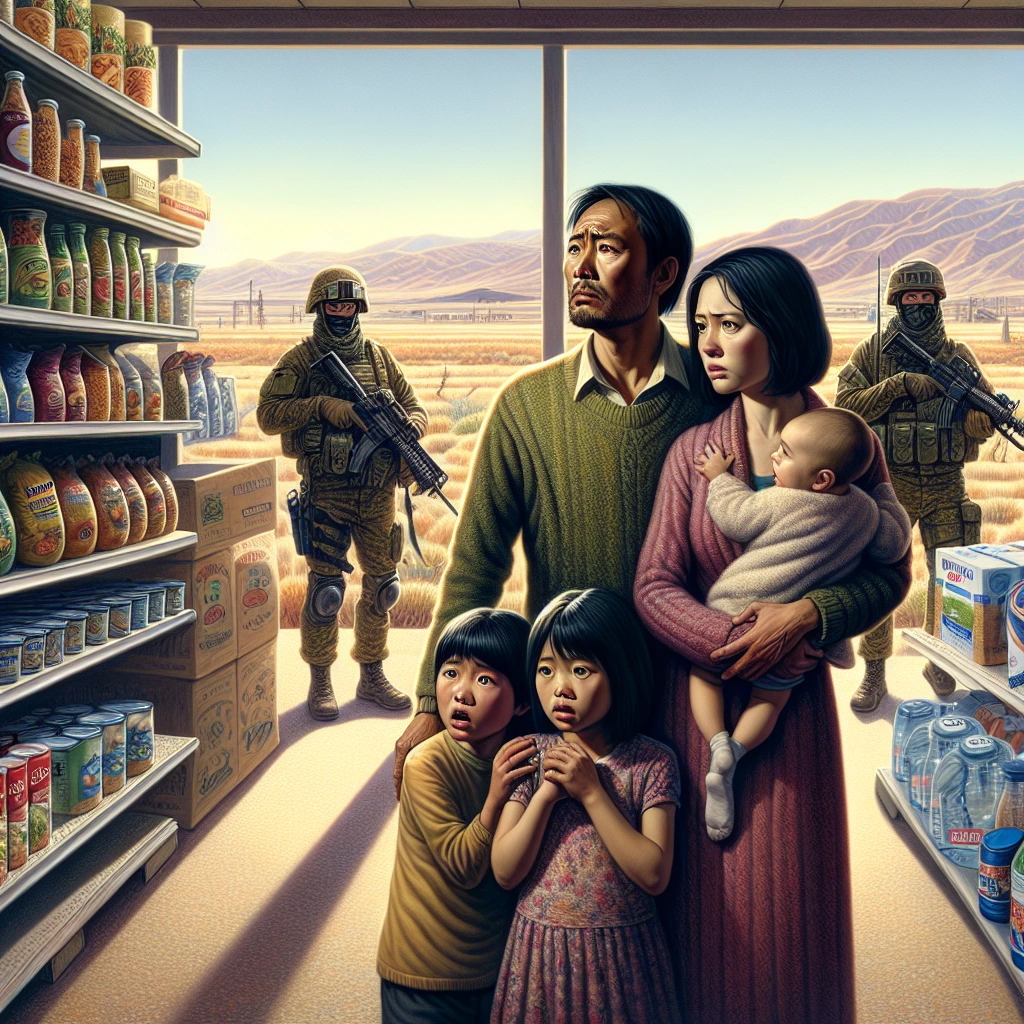

Food insecurity is defined as the lack of consistent access to enough food for an active, healthy life, and it is often exacerbated by conflict. Conflict can lead to food shortages and disrupt economic activities, threatening the means of survival for entire populations.
The impact of conflict on food security is significant, with warring parties often plundering food supplies and deliberately destroying civilian infrastructure, leading to severe disruptions in agricultural activities and food production.
Conflict can also drive food-related instability through climate change, competition over natural resources, and economic shocks. These factors contribute to the reduction of input availability for food production, increased reliance on less preferred foods, and overall decrease in access to food.
The 2023 Global Report on Food Crises noted that conflicts pushed over 117 million people into acute food insecurity, highlighting the direct link between conflict and exacerbation of food insecurity.
In conflict-affected areas, agricultural activities are disrupted, communities are displaced, and infrastructure is destroyed, all of which contribute to the perpetuation of food insecurity. This vicious cycle between conflict and food insecurity further exacerbates instability, threatening the peace and well-being of affected populations.
Understanding the pathways and impact of conflict on food security is crucial in addressing the root causes of food insecurity and developing effective solutions in conflict-affected regions.
Check out this Youtube video: “How Conflict Causes Food Insecurity” to learn about the impact of conflict on access to food and how it contributes to food insecurity around the world.
The Link Between Conflict and Food Insecurity
Increased Food Prices Due to Conflict
The impact of conflict on food prices is profound. For example, the war in Ukraine has disrupted agricultural commodity markets, resulting in elevated food prices globally.
This surge in prices can lead to severe food insecurity, with a 5% increase causing a 9% rise in children suffering from wasting, a form of acute malnutrition. The volatility in food prices, especially during times of conflict, exacerbates the challenge of ensuring food security for vulnerable populations.
Displacement and Disrupted Food Supply Chains
Conflicts often lead to the displacement of communities, disrupting food supply chains and economies. For instance, the displacement of farmers and destruction of agricultural assets can sever vital food value chains from production to marketing, impacting food availability.
Furthermore, conflict-related closures can prevent access to markets, leading to the disruption of the delicate food systems in rural communities. This disruption can further contribute to food shortages and intensify economic instability.
Destruction of Agricultural Infrastructure and Land
The destruction of agricultural infrastructure and land due to conflicts significantly impairs food production and availability. Disasters resulting from conflicts, such as the destruction of harvests, livestock, and irrigation systems, compound the vulnerability of societies to food insecurity.
Such destruction hampers the ability of farmers and agricultural systems to adapt to changing conditions, further exacerbating food insecurity.
| Factors | Impact |
|---|---|
| Increased Food Prices | Severe food insecurity, especially among children |
| Displacement and Disrupted Supply Chains | Disruption of food value chains, leading to food shortages |
| Destruction of Agricultural Infrastructure | Impaired food production and agricultural adaptation |
These aspects illustrate the intricate link between conflict and food insecurity, highlighting the need for comprehensive approaches to mitigate the impact of conflicts on food systems and ensure greater food security for affected populations.
The Impact on Agricultural Production
Decreased agricultural productivity
Conflict leads to decreased agricultural productivity due to destruction of farming infrastructure, disruption of farming activities, and displacement of farming communities. The instability and insecurity caused by conflict make it challenging for farmers to tend to their crops and livestock, resulting in reduced yields and overall productivity.
Difficulty accessing farming resources
Due to conflict, farmers face significant challenges in accessing essential farming resources such as seeds, fertilizers, and equipment. The disruption of supply chains, damage to infrastructure, and restrictions on movement make it difficult for farmers to obtain the necessary resources for successful agricultural production.
Loss of livestock and crops due to conflict-related damage
Conflict-related damage results in the loss of livestock and crops, further exacerbating food insecurity. Livestock is often killed or stolen, and crops are destroyed during conflict, leading to immediate food shortages and long-term economic consequences for farming communities.
| Impact | Consequence |
|---|---|
| Decreased productivity | Reduced yields, lower agricultural output, and economic hardship for farmers. |
| Difficulty accessing | Limited access to essential resources, hampering effective farming practices and hindering agricultural development. |
| farming resources | |
| Loss of livestock and | Diminished food supply, economic losses for farmers, and prolonged food insecurity within conflict-affected regions. |
| crops due to conflict- | |
| related damage |
Humanitarian Aid and Access to Food
Obstacles to delivering aid in conflict zones
Conflict zones present formidable challenges for delivering humanitarian aid, including logistical and security obstacles. Aid workers often face restricted access, threats of violence, and bureaucratic barriers, hindering the timely and effective delivery of essential assistance to those in need.
Limited access to food and nutrition assistance
In conflict-affected areas, limited access to food and nutrition assistance is a dire consequence. The ongoing violence disrupts agricultural activities, supply chains, and market access, leading to food scarcity and malnutrition among vulnerable populations, exacerbating the already precarious situation.
Threats to aid workers and food distribution
Aid workers and food distribution channels are under constant threat in conflict zones. Armed groups target humanitarian convoys and facilities, posing a significant risk to the safety and lives of aid workers and impeding the distribution of vital supplies to those in desperate need.
Health Consequences of Food Insecurity in Conflict Areas
Malnutrition and its effects on physical and mental health
Malnutrition in conflict areas greatly impacts physical and mental health. Undernutrition escalates the risk of infectious diseases such as diarrhoea, measles, and malaria. Similarly, chronic malnutrition can impede a child’s physical and mental development, leading to long-term consequences. For instance, micronutrient deficiencies can cause serious health issues, including anaemia, fatigue, weakness, and dizziness.
Spread of diseases and illnesses due to inadequate nutrition
Inadequate nutrition in conflict areas leads to the widespread spread of diseases and illnesses. Acute malnutrition weakens the immune system, making individuals more susceptible to fatal diseases. Malnutrition also compromises natural immunity, increasing susceptibility to infections and yielding more frequent and severe health issues.
Impact on vulnerable populations such as children and the elderly
Food insecurity in conflict areas significantly impacts vulnerable populations like children and the elderly. Children affected by conflict face a disproportionate burden of malnutrition and poor health outcomes, leading to stunted growth, underweight issues, anemia, and diarrhea. Similarly, food insecurity affects the health and well-being of elderly individuals, increasing their risk of chronic conditions such as diabetes, obesity, heart disease, and mental health disorders.
| Impact | Description |
|---|---|
| Physical Health | Undernutrition raises susceptibility to infectious diseases, while chronic malnutrition impairs physical and mental growth. |
| Spread of Diseases | Inadequate nutrition weakens immune systems, facilitating the widespread spread of fatal diseases. |
| Vulnerable Groups | Children and the elderly face disproportionate burdens of malnutrition and health issues in conflict areas. |
Economic Impact of Food Insecurity in Conflict Zones
Long-term consequences on local economies
Food insecurity resulting from conflict can have devastating long-term consequences on local economies. The destruction of infrastructure and disruption of normal economic activities, such as food production and trade, significantly hinders economic growth.
This leads to a continuous cycle of poverty and economic instability, making it challenging for local communities to recover and thrive.
Decreased income and livelihood opportunities
Conflict-induced food insecurity directly contributes to decreased income and livelihood opportunities for individuals and communities. With limited access to food supplies and disrupted agricultural activities, many individuals lose their means of earning a living, further exacerbating poverty and financial instability.
This lack of income perpetuates the cycle of food insecurity and economic hardship.
Strain on government resources and stability
The strain on government resources and stability is profound in conflict zones affected by food insecurity. Governments are burdened with the responsibility of providing food aid and support to affected populations, placing immense pressure on already limited resources.
Additionally, the instability caused by food insecurity can lead to social unrest and further challenges in maintaining law and order, posing significant threats to overall governmental stability.
| Impact | Description |
|---|---|
| Economic Consequences | Conflict-induced food insecurity leads to a decline in economic activities, hindering local economies and perpetuating poverty cycles. |
| Livelihood Challenges | Individuals experience decreased income and limited livelihood opportunities due to disrupted access to food supplies and agricultural activities. |
| Governmental Strain | Governments face challenges in allocating resources to address food insecurity, leading to social instability and increased pressure on governance. |
Social and Political Ramifications of Food Insecurity
Social unrest and potential for further conflict
The growing food insecurity can intensify social unrest and elevate the potential for further conflict. When communities face food shortages due to crop failures or limited resources, it fuels desperation and frustration among the population.
This can lead to protests, riots, and civil unrest as people struggle to access basic necessities. Moreover, the competition for scarce resources can escalate into conflicts between different groups vying for food supplies.
Political instability and tension
Food insecurity significantly contributes to political instability and tension within nations. Governments facing food shortages often encounter increased public dissatisfaction and unrest, which can challenge their authority and governance.
Additionally, the inability of political leaders to address food insecurity issues may lead to loss of public trust and confidence, triggering instability within the government. This can further heighten the existing tensions and potentially lead to political upheaval and conflicts.
Impact on social cohesion and community resilience
The impact of food insecurity on social cohesion and community resilience is profound. In times of scarcity, communities may experience internal strain and discord as individuals and groups struggle to meet their basic nutritional needs.
This can erode the social fabric and weaken the collaborative efforts needed to address the underlying challenges. Furthermore, persistent food insecurity can compromise the resilience of communities, making them more vulnerable to external shocks and hindering their ability to recover from crises.
| Aspect | Impact |
|---|---|
| Social unrest | Raises risks of protests, riots, and conflicts over scarce resources |
| Political instability | Leads to public dissatisfaction, loss of trust, and potential upheaval |
| Community resilience | Undermines collaborative efforts and weakens resilience |
By addressing food insecurity proactively, nations can mitigate these risks, promote stability, and foster stronger, more resilient communities.
Gender Dynamics in Conflict-Related Food Insecurity
The impact of conflict on food insecurity has a disproportionate effect on women and girls. Statistics reveal that 60 percent of the 690 million food-insecure individuals worldwide are women and girls.
This gender imbalance exacerbates the challenges faced by women in conflict zones, creating heightened vulnerability in accessing essential resources.
In conflict-affected areas, women experience an increased burden to provide food and care for their families. With disrupted supply chains and limited access to resources, women are thrust into the forefront of ensuring the well-being of their families, amplifying the challenges they face during food insecurity.
Furthermore, women encounter significant challenges in accessing food and essential resources in conflict areas. With disrupted supply chains, limited access to markets, and increased risks of violence, women struggle to secure adequate food and resources for their families, further exacerbating the impact of conflict-related food insecurity on their well-being and that of their families.
| Types of Impact | Description |
|---|---|
| Disproportionate Impact on Women and Girls | 60% of the 690 million food-insecure individuals are women and girls |
| Increased Burden on Women | Women bear the added responsibility of providing food and care for their families in conflict-affected areas |
| Challenges in Accessing Food and Resources | Women face difficulties in accessing essential resources due to disrupted supply chains and increased risks in conflict areas |
The underlying gender dynamics in conflict-related food insecurity demand targeted interventions and support systems to address the specific challenges faced by women and girls in these circumstances.
Conflict and Climate Change: A Vicious Cycle
Environmental degradation and its impact on food security in conflict zones
Environmental degradation in conflict zones directly contributes to food insecurity by disrupting agricultural activities, destroying infrastructure, and depleting natural resources. In war-torn regions, indiscriminate use of landmines and explosives contaminates soil, rendering it unsuitable for farming.
Additionally, deforestation and widespread pollution further exacerbate the food crisis, limiting access to nutritious produce. The displacement of communities due to conflict also leads to overcrowding in refugee camps, straining already scarce food resources.
Climate-related disasters and their role in exacerbating food insecurity
Climate-related disasters, such as droughts, floods, and severe storms, significantly intensify food insecurity in conflict-affected areas. These disasters disrupt agricultural cycles, destroy crops, and displace farming communities, leading to reduced food production and increased food prices.
The interconnectedness of conflict and climate change amplifies the impact of these disasters, making it challenging for affected regions to recover and rebuild food systems. The compounding effects of conflict and climate-related disasters create a vicious cycle of food insecurity.
Need for sustainable solutions to address the intersection of conflict, food insecurity, and climate change
Addressing the intersection of conflict, food insecurity, and climate change requires sustainable solutions that prioritize long-term resilience and adaptation. Investing in climate-smart agricultural practices, promoting renewable energy sources, and implementing efficient resource management strategies are crucial steps toward mitigating the impact of environmental degradation and climate-related disasters on food security in conflict zones.
Moreover, fostering international cooperation and policy frameworks aimed at conflict prevention and environmental protection is essential to break the cycle of food insecurity perpetuated by conflict and climate change.
| Sustainable Solutions |
|---|
| Climate-smart agricultural practices |
| Implementation of renewable energy sources |
| Efficient resource management strategies |
| International cooperation and conflict prevention policy frameworks |
International Response and Aid Efforts
Role of international organizations in addressing food insecurity in conflict areas
The role of international organizations in addressing food insecurity in conflict areas is crucial. Organizations like the World Food Programme and the Food and Agricultural Organization play a pivotal role in providing humanitarian assistance to those affected by conflict-induced food insecurity.
By delivering food aid and supporting agricultural projects, these organizations work tirelessly to ensure that vulnerable populations have access to adequate nutrition despite the challenges posed by conflict.
Challenges in coordinating and delivering aid
Coordinating and delivering aid in conflict areas presents unique and formidable challenges. The intensity of the conflict, along with issues such as restricted access, security threats, and logistical barriers, hinders the efficient and timely distribution of aid.
International organizations often face difficulties in reaching affected populations, which can further exacerbate food insecurity in these areas. Additionally, political complexities and the risk of aid diversion pose significant hurdles in coordinating and delivering aid to those in need.
Effectiveness of current aid strategies and potential for improvement
The effectiveness of current aid strategies in conflict areas is hindered by the complex nature of the challenges. While international organizations work tirelessly to provide aid, the potential for improvement lies in addressing the root causes of conflict and food insecurity.
Collaborative efforts that integrate diplomatic, foreign assistance, and defense engagement can play a vital role in enhancing aid effectiveness. Moreover, systematic application of aid to stabilize conflict-affected areas can lead to more impactful and sustainable outcomes.
| Challenges | Solutions |
|---|---|
| Restricted access | Diplomatic negotiations for improved access |
| Security threats | Enhanced security measures for aid delivery |
| Logistical barriers | Innovative logistical solutions and technology integration |
The Role of Local and Community-Based Solutions
Importance of localized approaches to addressing food insecurity in conflict zones
Localized approaches are crucial in addressing food insecurity in conflict zones because they allow for tailored solutions that consider the specific needs and challenges of each community. By understanding the localized factors contributing to food insecurity, such as supply chain disruptions and access limitations, targeted interventions can be implemented to effectively address the root causes of the issue.
For example, in conflict-affected regions where agricultural production is impeded, localized approaches may emphasize alternative livelihood strategies or the provision of specific agricultural support tailored to the local context.
Community resilience and capacity-building efforts
Community resilience and capacity-building efforts play a vital role in combating food insecurity in conflict zones. By empowering local communities to develop sustainable food production methods, enhance food storage capabilities, and bolster emergency response mechanisms, the resilience of these communities is fortified.
For instance, empowering local farmers with knowledge on drought-resistant crops or promoting collective food storage initiatives can significantly increase the community’s ability to withstand and recover from food crises amidst conflict.
Empowerment of local actors in shaping responses to food insecurity in their communities
The empowerment of local actors is essential in shaping responses to food insecurity within their communities as they possess in-depth knowledge of local dynamics, cultural nuances, and community needs. By engaging local NGOs, community-based organizations, and leaders in decision-making processes, interventions can be more contextually relevant and sustainable.
For example, involving local agricultural cooperatives in devising strategies for improving food access and distribution can ensure that the responses are aligned with the community’s unique requirements.
Case Studies on Conflict-Related Food Insecurity
Examples of conflicts leading to food insecurity
One glaring example of conflicts leading to food insecurity is the civil war in South Sudan, which erupted in 2013, leaving the world’s youngest nation grappling with extreme poverty and food shortages. Additionally, farmer-herder conflicts in the African Sahel, particularly in Nigeria, central Mali, and northern Burkina Faso, have significantly contributed to food-related instability, exacerbating the already precarious conditions in these regions.
Lessons learned and best practices from past interventions
From past interventions, it has been evident that successful innovative solutions are crucial in addressing food security in conflict-affected areas. These interventions have highlighted the importance of innovative partnerships, local solution identification, and the utilization of community resources.
Moreover, it has become clear that aid, though essential, can have a minimal impact on reducing food insecurity and mitigating hardships in conflict-prone regions.
Potential strategies for preventing and mitigating food insecurity in conflict-affected areas
When devising strategies for preventing and mitigating food insecurity in conflict-affected areas, it is imperative to focus on strengthening preparedness and resilience. This includes providing rapid and substantial support to vulnerable populations through humanitarian assistance, enhancing access to essential infrastructure such as wells and irrigation systems, and establishing mechanisms to protect and safeguard food supplies amid conflicts.
Addressing the Root Causes of Conflict-Related Food Insecurity
Importance of addressing underlying conflict issues
The importance of addressing underlying conflict issues lies in the fact that conflict disrupts food production and distribution, leading to widespread food insecurity. By addressing the root causes of conflict, such as political instability or economic disparities, it becomes possible to create conditions for stable food production and distribution, thereby mitigating food insecurity in conflict-affected areas.
Sustainable peacebuilding and conflict resolution strategies
Sustainable peacebuilding and conflict resolution strategies play a crucial role in addressing food insecurity in conflict zones. By fostering long-term stability and peaceful coexistence, these strategies create an environment conducive to agricultural development and ensure unimpeded access to food supplies, ultimately combating food insecurity in conflict-affected regions.
Role of diplomacy and international cooperation in preventing food insecurity in conflict zones
Diplomacy and international cooperation are pivotal in preventing food insecurity in conflict zones. By fostering dialogue and collaboration among nations, it becomes possible to address the underlying causes of conflict, leading to stable environments for food production and distribution.
Moreover, international aid and cooperation can provide essential resources to alleviate immediate food shortages in conflict-affected areas, contributing to the prevention of food insecurity.
| Conflict-related Food Insecurity | Prevention Strategies |
|---|---|
| Address underlying conflict issues | Political stability, economic equality |
| Sustainable peacebuilding and resolution | Long-term stability, peaceful coexistence |
| Role of diplomacy and international cooperation | Fostering dialogue, international aid and collaboration |
The Need for Long-Term Solutions
Importance of investing in sustainable development and resilience-building efforts
Investing in sustainable development and resilience-building efforts is crucial for addressing conflict-related food insecurity. By focusing on sustainable development, we can create long-term solutions that not only tackle immediate food insecurity but also prevent its recurrence. Utilizing renewable energy sources, promoting sustainable agriculture, and fostering environmentally friendly practices are essential components of sustainable development efforts. Additionally, investing in resilient infrastructure and disaster preparedness measures can help communities withstand the impact of conflicts on food security and ensure continuity of food supplies during disruptive events.
Integration of food security into conflict prevention and peacebuilding initiatives
Integrating food security into conflict prevention and peacebuilding initiatives is imperative for fostering stability and reducing the impact of conflicts on food availability. By prioritizing food security within peace efforts, we can address the root causes of conflict and mitigate the negative impact on food supplies. This involves incorporating food security measures into conflict resolution strategies, humanitarian aid programs, and peacebuilding initiatives. By doing so, we can create more sustainable peace and reduce the risk of food insecurity resulting from conflicts and humanitarian crises.
Holistic approaches to addressing the complex challenges of conflict-related food insecurity
Adopting holistic approaches is essential for effectively addressing the multifaceted challenges of conflict-related food insecurity. This approach involves considering various interconnected factors such as economic, environmental, and social dynamics that contribute to food insecurity during conflicts. By taking a comprehensive view, we can implement strategies that not only address immediate food shortages but also build resilience and sustainable food systems. This may involve promoting inclusive economic growth, sustainable natural resource management, and fostering social cohesion to create lasting solutions that withstand the impacts of conflicts on food security.
| Sustainable Development Initiatives | Benefits |
|---|---|
| Renewable energy sources | Less environmental impact, long-term energy availability |
| Sustainable agriculture practices | Enhanced soil fertility, reduced dependency on external inputs |
| Resilient infrastructure | Increased community resilience, reduced vulnerability to conflicts and disasters |
Integrating sustainable development, food security, and conflict prevention efforts is essential for tackling conflict-related food insecurity, fostering stability, and building resilient communities. By implementing holistic approaches and investing in sustainable initiatives, we can work towards creating long-term solutions and mitigating the impact of conflicts on food security.
Research and Data on Conflict-Related Food Insecurity
Importance of evidence-based approaches to understanding and addressing food insecurity in conflict areas
It’s tremendously important to embrace evidence-based approaches when it comes to understanding and addressing food insecurity in conflict areas. Without this, we’re just shooting in the dark.
It’s like trying to build a house without a blueprint – it’s just not gonna work! Data-driven strategies help us truly grasp the extent of the problem and tailor our interventions for maximum impact.
For example, a study by the United Nations showed that in conflict-affected countries, households are 50% more likely to experience severe food insecurity. This hard evidence guides our actions and ensures we’re on the right track.
Data gaps and challenges in researching conflict-related food insecurity
But, let’s face it, it’s not all smooth sailing. Dealing with conflict-related food insecurity comes with its own set of challenges, especially when it comes to data.
Sometimes, the areas affected by conflict are so volatile and dangerous that collecting accurate data becomes near impossible. It’s like trying to count the stars in a storm – it’s a messy business.
This lack of precise data can hinder our efforts to fully understand the scope of the problem and devise effective solutions. For instance, in war-torn regions, many households don’t have access to regular surveys or census, leading to significant data gaps.
Opportunities for further research and knowledge generation in this field
Despite the obstacles, there are promising opportunities for further research and knowledge generation in this crucial field. For instance, advances in technology are opening up new avenues for data collection, like satellite imagery and mobile-based surveys.
These innovative approaches can help fill the existing data gaps and give us a more comprehensive understanding of conflict-related food insecurity. In addition, partnerships between humanitarian organizations, governments, and academic institutions can foster collaborative research, bringing fresh perspectives and expertise to the table.
This synergy paves the way for groundbreaking discoveries that can revolutionize our approach to addressing food insecurity in conflict-affected regions.
| Interventions | Effectiveness |
|---|---|
| Access to federal nutrition programs | Rated based on their effectiveness |
| Just food policies | Ethical framework characterized by four principles |
| Research priorities | Describe key food security risks and opportunities |
| Data and information on conflict | Methodology for terminating dangerous cycles between food insecurity and violent conflict |
Evidence-based approaches are crucial for addressing food insecurity in conflict areas. While data gaps present challenges, innovative research methods and collaborative partnerships hold the key to unlocking deeper insights and more effective interventions in the future.
Together, we can make a meaningful impact in alleviating food insecurity in conflict-affected regions.
Advocacy and Awareness Raising
Role of advocacy in raising awareness about conflict-related food insecurity
Advocacy plays a crucial role in shedding light on the impact of conflict on food insecurity. By advocating for policies and interventions, we can educate the public and policymakers about the root causes and consequences of food insecurity in conflict zones.
This awareness helps generate support for sustainable solutions to address the issue.
Opportunities for individuals and organizations to support efforts to address this issue
Individuals and organizations have unique opportunities to support efforts to address conflict-related food insecurity. They can contribute by funding humanitarian aid, participating in advocacy campaigns, and collaborating with local communities to implement sustainable food programs.
Additionally, leveraging social media and raising funds for NGOs working in conflict zones can make a significant impact.
Importance of amplifying the voices of those affected by food insecurity in conflict zones
Amplifying the voices of those affected by food insecurity in conflict zones is paramount. By sharing their stories and experiences, we humanize the issue, creating empathy and understanding.
This can lead to increased support and resources, empowering affected communities and fostering a collective effort to alleviate food insecurity in conflict-affected areas.
Recommended Amazon Products for Conflict-Related Food Insecurity
Here’s a curated list of products that can help address the challenges of conflict-related food insecurity. These recommendations are based on their relevance to providing aid, support, and solutions to individuals and communities affected by food insecurity in conflict zones.
MRE (Meals, Ready to Eat) Emergency Food Ration


MREs are compact, long-lasting, and ready-to-eat meals that provide essential nutrition in emergency situations. These are vital for addressing limited access to food and nutrition assistance in conflict areas.
| Pros | Cons |
|---|---|
| Long shelf life | High sodium content |
| No preparation needed | Limited variety of meals |
| Portable and lightweight | Not suitable for long-term use |
LifeStraw Personal Water Filter


This portable water filter is crucial for ensuring access to safe and clean drinking water in conflict-affected areas where water sources may be compromised or contaminated.
| Pros | Cons |
|---|---|
| Removes 99.9999% of waterborne bacteria | Not suitable for saltwater or chemically contaminated water |
| Lightweight and compact design | Requires regular maintenance |
| Long filter lifespan | Slower flow rate for filtering |
Benevolence Farming Seeds Variety Pack


Supporting agriculture and providing resources for farming is essential in addressing decreased agricultural productivity and the loss of livestock and crops due to conflict-related damage.
| Pros | Cons |
|---|---|
| Wide variety of non-GMO seeds | Limited shelf life for seeds |
| Suitable for various climates | Requires knowledge of farming practices |
| Provides sustainable food sources | Weather and soil conditions may impact success |
Medical First Aid Kit


Access to medical supplies and aid is crucial in addressing the health consequences of food insecurity in conflict areas, including malnutrition and the spread of diseases due to inadequate nutrition.
| Pros | Cons |
|---|---|
| Comprehensive first aid supplies | Limited treatment capabilities for severe injuries |
| Portable and easy to carry | Expiration dates for some items |
| Suitable for various medical emergencies | May require additional training for use |
Solar-Powered Portable Lantern


Light sources such as solar-powered lanterns are essential for individuals and communities in conflict zones, providing a sense of security and safety, especially during nighttime.
| Pros | Cons |
|---|---|
| Environmentally friendly and sustainable | Dependent on sunlight for charging |
| Portable and durable design | May not be suitable for prolonged use during limited sunlight |
| Provides long-lasting illumination | Higher upfront cost for solar technology |
Top Recommended Product for Conflict-Related Food Insecurity
If you’re looking for the best solution for addressing conflict-related food insecurity, we highly recommend the MRE (Meals, Ready to Eat) Emergency Food Ration (https://www.amazon.com/s?k=MRE+Emergency+Food+Ration). MREs offer a compact, long shelf life, and a variety of essential nutrition, making them an invaluable resource for individuals and communities in conflict-affected areas. Ready to address conflict-related food insecurity? Check out the MRE (Meals, Ready to Eat) Emergency Food Ration (https://www.amazon.com/s?k=MRE+Emergency+Food+Ration) today for the best results!


Conclusion
Conflict has a significant impact on food insecurity, leading to disruptions in food production, distribution, and access. The destruction of agricultural infrastructure and livestock, along with displacement of farmers and food shortages, exacerbate the problem, leaving communities vulnerable to hunger and malnutrition.
Conflict not only directly affects food production and availability, but it also disrupts markets and trade, making food unaffordable for many people.
Furthermore, it is crucial to address the root causes and consequences of food insecurity exacerbated by conflict. It is essential to prioritize peacebuilding and conflict resolution efforts to create stability and security, enabling food production and distribution to resume.
Additionally, supporting small-scale farmers, investing in agricultural infrastructure, and providing access to education and resources can help build resilience and mitigate the impact of conflict on food security. Governments, international organizations, and local communities must work together to address the urgent issue of food insecurity in conflict-affected areas and ensure that everyone has access to an adequate and nutritious diet.



